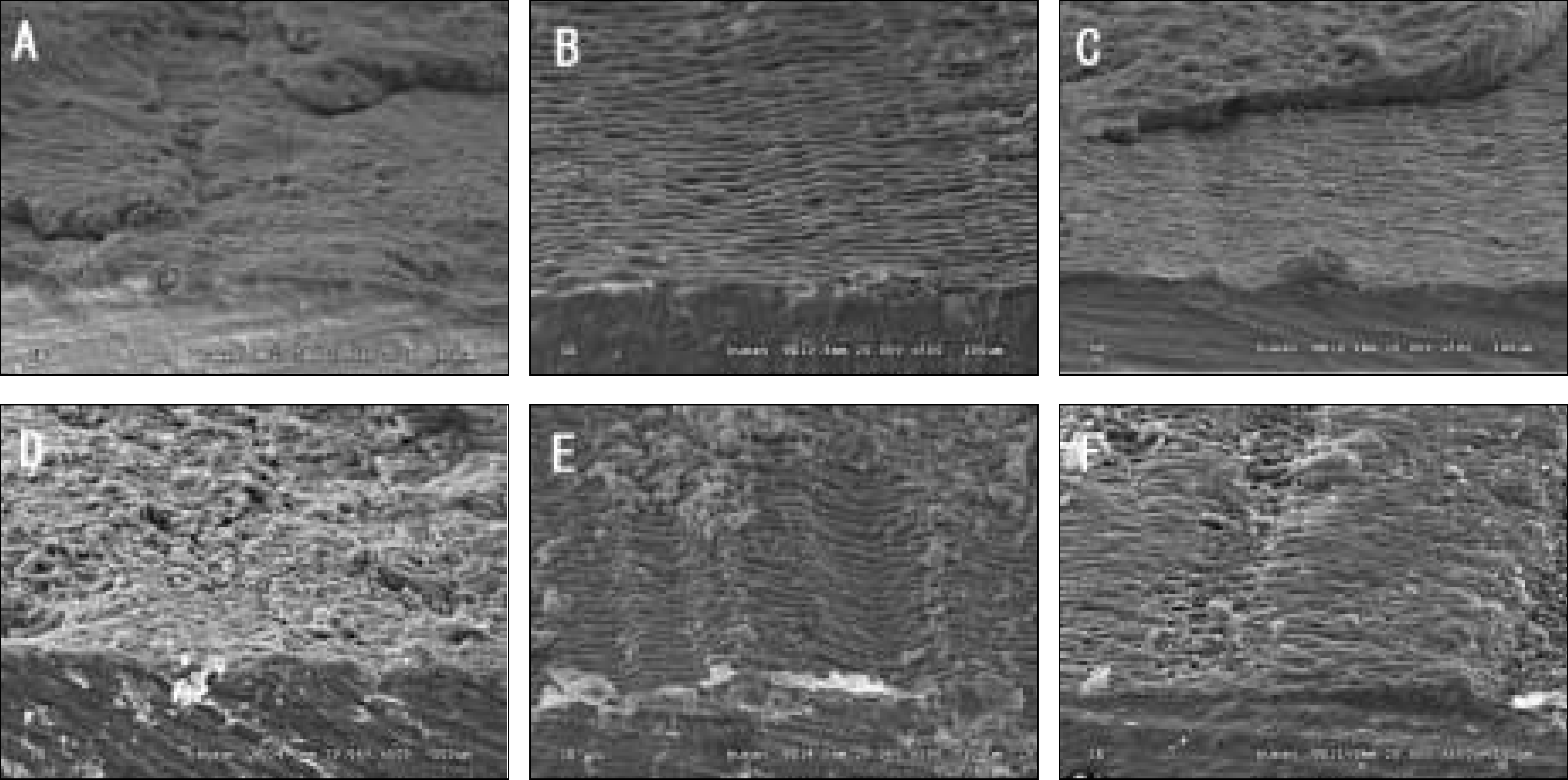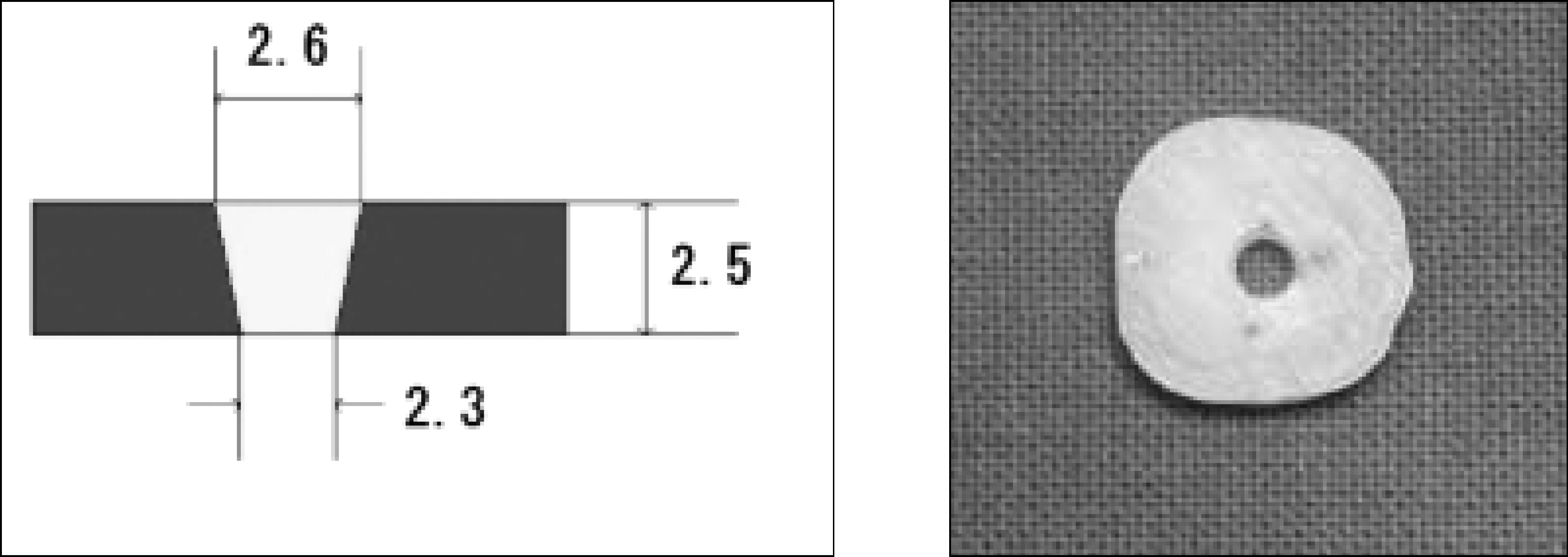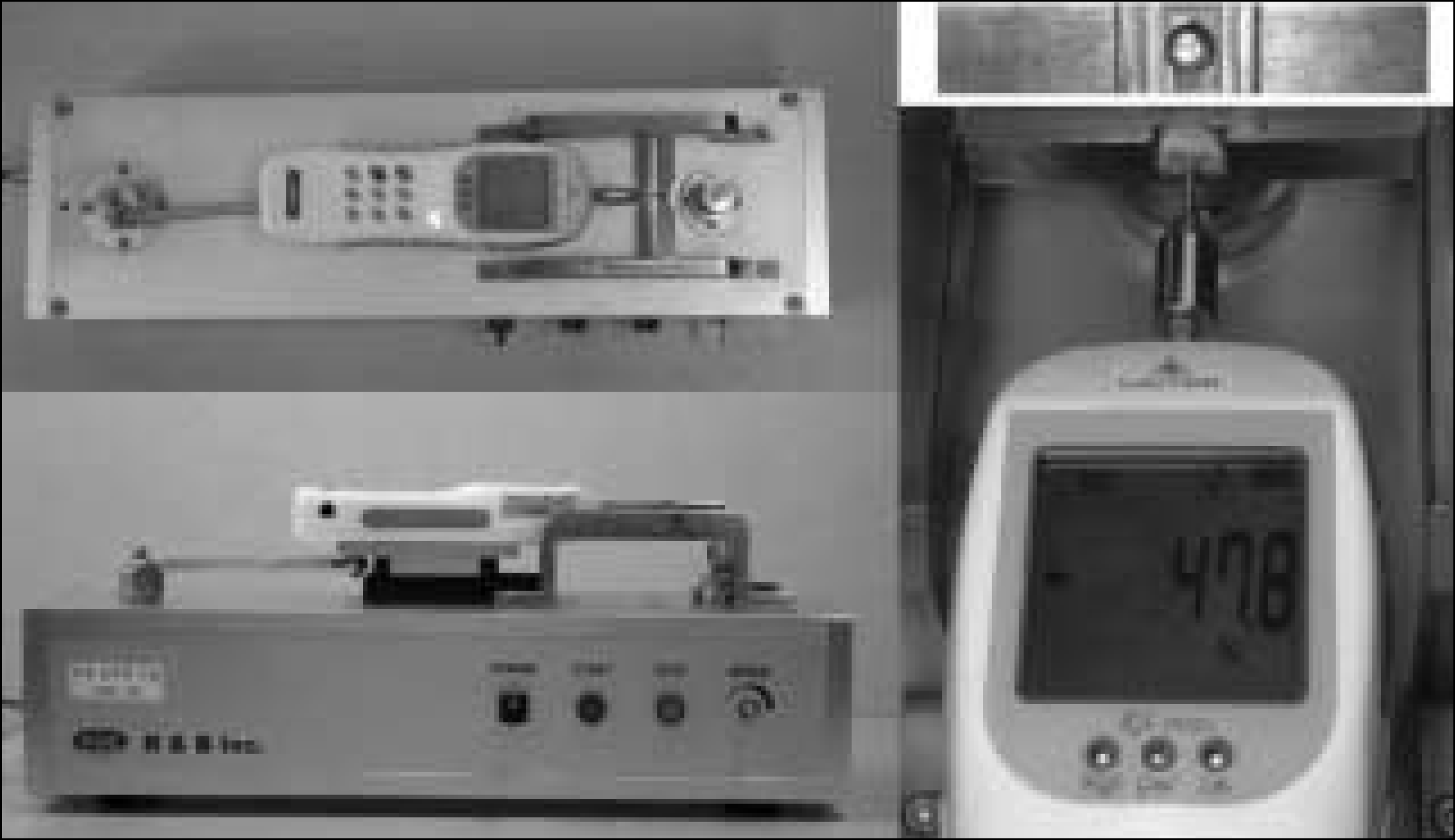Abstract
The purpose of this study was to evaluate the effect of additional etching procedure prior to Maxcem resin cement application in indirect restoration cementation using push-out bonding strength.
One hundred and two extracted human molars were used to make indirect resin restorations of gold inlay and Synfony. These restorations were cemented using Maxcem and Variolink II. Additional etching procedures were done for one group with Maxcem. Three groups have 17 specimens in both restoration types. Push-out bond strength was measured using multi-purpose tester and calculated for bonding strength per sqaure-millimeter area. The mean bonding strength values were compared using SPSS 12.0K program for one-way ANOVA and Scheffe's Test with 95% significance.
Under the condition of this study, the additional etching procedure prior to usage of Maxcem resulted in reduced bond strength for both of restoration types.
Go to : 
참고문헌
1. Kelsey WP, Triolo PT, Blankenau RJ, Kelsey MN, Chad O, Dan Hauser. Bond strength to enamel and dentin with indirect and direct resin composite. Am J Dent. 9(3):105–108. 1996.
2. Gerard K. Direct and indirect adhesive restorative material: A review. Am J Dent. 13:35–40. 2000.
3. Frankenberger R, Kramer N, Petschelt A. Technique sensitivity of dentin bonding: effect of application mistakes on bond strength and marginal adaptation. Oper Dent. 25:324–330. 2000.
4. Mark YF, Lai SC, Cheung GS, Chan AW, Tay FR. Pashley DH Micro-tensile bond strength of resin cements to dentin and an indirect resin composite. Dent Mater. 18:609–621. 2002.
5. Holderegger C, Sailer I, Schuhmacher C, Schla¨pfer R, Ha¨mmerle C, Fischer J. Shear bond strength of resin cements to human dentin. Dent Mater. 24(7):944–950. 2008.

6. Linlin H, Akira O, Masayoshi F, Takashi OI. Evaluation of physical properties and surface degradation of self-adhesive resin cements. Dent Mater. 26(6):906–914. 2007.
7. Buonocore MG. A simple method of increasing the adhesion acrylic filling material to enamel surface. J Dent Res. 34:846–851. 1955.
8. Hagger O. British patent no. 687. 299:1951.
9. Tanumiharja M, Burrow MF, Tyas MJ. Microtensile bond strengths of seven dentin adhesive systems. Dent Mater. 16(3):180–187. 2000.

10. Pashley EL, Agee KA, Pashley DH, Tay FR. Effects of one versus two applications of an unfilled, all-in-one adhesive on dentine bonding. J Dent. 30(2-3):83–90. 2002.

11. Bouillaguet S, Gysi P, Wataha JC, Ciucchi B, Cattani M, Godin C, Meyer JM. Bond strength of composite to dentin using conventional, one-step and self-etching adhesive systems. J Dent. 29:55–61. 2001.

12. 김 도완, 박 상진, 최 경규. 자가부식형 상아질 접착제와 레진 시 멘트와의 적합성에 관한 연구. 대한치과보존학회지. 30:493–504. 2005.
13. 조 민우, 박 상혁, 김 종률, 최 경규. 레진시멘트의 접착 내구성에 관한 연구. 대한치과보존학회지. 32:343–355. 2007.
14. De Munck J, Vargas M, Van Landuyt K, Hikita K, Lambrechts P, Van Meerbeek B. Bonding of an auto-adhesive luting material to enamel and dentin. Dent Mater. 20:963–971. 2004.
15. Oliver F. Creating a reliable bond. An all-in-one system. Am J Dent. 13:85–87. 2006.
16. Tseng WY, Chen MH, Lu HH, Lin CW, Hsieh TT, Chen CH, Lai JY, Lee BS. Tensile bond strength of Er, Cr: YSGG laser-irradiated human dentin to composite inlays with two resin cements. Dent Mater. 6(5):746–55. 2007.

17. Saskalauskaite E, Tam LE, McComb D. Flexural Strength, Elastic Modulus, and pH Profile of Self-etch Resin Luting Cements. J Prosthodont Dec 14 [E pub]. 2007.

18. Senyilmaz DP, Palin WM, Shortall AC, Burke FJ. The effect of surface preparation and luting agent on bond strength to a zirconium-based ceramic. Oper Dent. 32(6):623–630. 2007.

19. Faltermeier A, Behr M, Mussig D. A comparative evaluation of bracket bonding with 1-, 2-, and 3-component adhesive systems. Am J Orthod Dentofacial Orthop. 132(2):144.e1–5. 2007.

20. Frankenberger R, Lohbauer U, Schaible RB, Nikolaenko SA, Naumann M. Luting of ceramic inlays in vitro: marginal quality of self-etch and etch-and-rinse adhesives versus self-etch cements. Dent Mater. 24(2):185–191. 2008.

21. Goracci C, Cury AH, Cantoro A, Papacchini F, Tay FR, Ferrari M. Microtensile bond strength and interfacial properties of self-etching and self-adhesive resin cements used to lute composite onlays under different seating forces. J Adhes Dent. 8(5):327–335. 2006.
22. Bishara SE, Ajlouni R, Laffoon JF, Warren JJ. Comparison of shear bond strength of two self-etch primer/adhesive systems. Angle Orthod. 76(1):123–126. 2006.
23. Patierno JM, Rueggeberg FA, Anderson RW, Weller RN, Pashley DH. Push-out strength and SEM evaluation of resin composite bonded to internal cervical dentin. Endod Dent Traumatol. 12:227–236. 1996.

24. House K, Sheriff M. An in-vitro investigation into the use of a single component self-etching primer adhesive system for orthodontic bonding: a pilot study. J Orthod. 33:116–124. 2006.
25. Frankenberger R, Kramer N, Oberschachtsiek H, Petschelt A. Dentin bond strength and marginal adaption after NaOCl pre-treatment. Oper Dent. 25:40–45. 2000.
26. Swift EJ Jr, Wilder AD Jr, May KN Jr, Waddell SL. Shear bond strengths of one-bottle dentin adhesives using multiple applications. Oper Dent. 22:194–199. 1997.
27. Fritz UB, Finger WJ. Bonding efficiency of single-bottle enamel/dentin adhesives. Am J Dent. 12:277–282. 1999.
28. Miyazaki M, Ando S, Hinoura K, Onose H, Moore BK. Influence of filler addition to bonding agents on shear bond strength to bovine dentin. Dent Mater. 11:234–238. 1995.

29. Gallo JR, Comeaux R, Haines B, Xu X, Burgess JO. Shear bond strength of four filled dentin bonding systems. Oper Dent. 26:44–47. 2001.
30. Ai H, Nagai M. Effect of the adhesive layer thickness on the fracture toughness of dental adhesive resins. Dent Mater. 19(2):153–163. 2000.

31. Zheng L, Pereira PN, Nakajima M, Sano H, Tagami J. Relationship between adhesive thickness and microten-sile bond strength. Oper Dent. 26(1):97–104. 2001.
32. Walshaw PR, McComb D. Clinical considerations for optimal dentinal bonding. Quintessence Int. 27(9):619–625. 1996.
Go to : 
 | Figure 3.Representatives of SEM examination of failure surfaces of A; GMC, B; GME, C; GVL, D; RMC, E; RME, and F; RVL. |
Table 1.
Bonding systems used in this study
| Brand of Resin cement | Adhesive system | Composition |
|---|---|---|
| Variolink II | Total Etch; 37% phosphoric acid | |
| Excite DSC; HEMA*, dimethacrylate, phosphonic | ||
| Total-etching | acid acrylate, silicon dioxide | |
| Adhesive resin; Bis-GMA**, urethane | ||
| dimethacrylate, filler | ||
|
|
||
| Maxcem | Base Paste; Uretanedimethacrylate, | |
| Self-etching | Camphoroquinone, Fluoroaluminosilicate, other | |
| & | Catalyst Paste; Bis-GMA**, | |
| Self-adhesive | Triethyleneglycoldimethacrylate, | |
| Glycerophosphatedimethacrylate, other | ||
Table 2.
Group classification and adhesive methods for each groups




 PDF
PDF ePub
ePub Citation
Citation Print
Print




 XML Download
XML Download